Do you sometimes experience tense, hardened, or cramped calves after or during a run? Well, you’re not alone.
Most experienced runners can recall at least one time they’ve found themselves on the side of the course rubbing a calf to alleviate a cramp.
For runners, tight calves are a very common problem and can range from being a mild nuisance to being quite painful. There are a variety of conditions that affect the calf muscles and cause tightness or soreness in the lower leg.
The good news is that many of these conditions are treatable and preventable.

So, what are the symptoms of tight calves?
Symptoms Of Tight Calves
There are so many different causes of tight calves which makes the symptoms vary considerably.
Symptoms of tight calves include:
- Cramping in the calf muscle.
- Sudden pain in the back of your calf or behind your knee.
- Difficulty standing on your tiptoes.
- Pain when resistance is applied to the muscles.
- Pain in the calf while resting or during exercise.
- Limited mobility in your ankle.
- Numbness or tingling along the lower leg.
What Causes Tight Calf Muscles
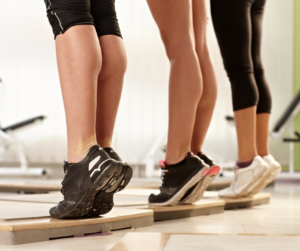
Tight calves may be the result of a strain or tear in one of the calf muscles or it could be due to a cramp or spasm in the muscle, which is painful.
We actually don’t know how to treat cramping. If we did we would be millionaires living on an island somewhere…
Tightness in the calf muscle is also sometimes a symptom of overuse so if you are experiencing some pain and stiffness it might be a signal from your body that you are placing too much of a load on your muscles.
5 reasons you may have tight calf muscles:
- Cramps in the calves
- Overuse – Simply training too much/not recovering enough
- A muscle strain or pulling a calf muscle
- A lack of warming up
- Poor biomechanics in the foot
Let’s have a look at these reasons in more detail…
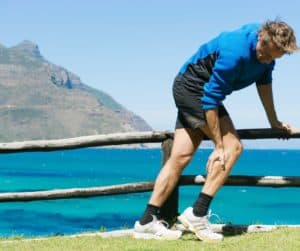
Cramping In Your Calf Muscle
Cramps in the calf muscles are very common.
We do not know EXACTLY what causes cramps.
Cramps are seldom caused by a lack of electrolytes and in cases where this is the case, it’s generally accompanied by nighttime cramping.
It’s important to note that while a shortage of electrolytes in extreme conditions can contribute to cramping, too high a concentration of electrolytes will have the same impact as too little.
There is only one mechanism for cramps: Cross Bridge fatigue.
Simply put, as we proceed with exercise, there is an association with fatigue, a gradual decay in the signaling that instructs the muscles to contract and relax.
As this process delays, we get to a point where your agonist (calf) and antagonist (peroneal and/or anterior tibialis) contract at the same time, which leads to cramping.
The cause of this cross-bridge fatigue is most commonly from muscle fatigue and in less than 30% of cases from nutrition (low magnesium, calcium, and/or potassium).
Strength training is likely contributing to this fatigue in the shorter term but should assist in the longer term.
Here at Coach Parry, we’re massive advocates of strength training. We’ve put together this free strength training plan for runners that you can do once a week, at home and with no expensive equipment needed. You can access it by clicking here.
Overuse
Just like any muscle in your body, adaptation to an increased training load takes time. If you increase that load too quickly or if you continue to train without allowing your calf muscles to recover, you run the risk of picking up an overuse injury.
Your calf muscles are used daily, especially if you’re a runner, and when you haven’t warmed up before a run or stretched properly afterward, their flexibility is limited.
This puts more strain and pressure on other parts of your legs and makes you more susceptible to pain, tightness, and injury.
Running is very taxing on your calf muscles and lower limb stabilizers. Therefore if there is an imbalance between stabilizers and prime movers then the smaller muscles work overtime and the bigger muscle groups just take over. This then causes extra stress on ligaments and tendons around these structures, which can lead to injury. So people who train too hard or too long are at higher risk of getting calf tightness, pain, or cramps.
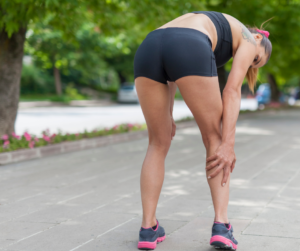
A Calf Muscle Strain/ Pull
Many muscles run along the back of your lower leg but there are two of the biggest ones – the Gastrocnemius muscle and the Soleus muscle.
The Gastrocnemius (prime mover) is a large muscle that runs from the top of the knee joint to the heel of the foot while the smaller Soleus muscle (stabilizer) lies underneath the Gastrocnemius and attaches to the bottom of the knee joint down to the heel.
A muscle strain is when a tear occurs in the muscle fiber. The pain and tightness of the calf will then depend on the severity of the tear. Symptoms of a muscle strain include sharp, sudden pain and tenderness around the muscle.

Lack of a Warm-Up
A lack of a proper warm-up routine before your run, or not consistently stretching or foam rolling/massaging your calves before or after running could be the cause of the muscle tightness you’re experiencing in your calves.
If you don’t stretch your calf muscles regularly then your muscles may shorten and therefore become tighter.
Note: Wearing high heels constantly also results in adaptive shortening of the calf muscles.
Foot Biomechanics
Your running style, the way your foot hits the ground when you are running and your ankle mobility could also contribute to calf tightness.
If mobility is something you struggle with, then grab our free mobility flow that you can do at home by clicking here.

Overpronating (when the foot rolls in or flattens) can put a strain on your calf muscles every time you run or walk, which may cause the muscle to tighten in response to the repetitive strain.
We all pronate. The foot needs to pronate to create what we call the windlass mechanism. If the foot is not strong enough THEN this becomes a problem. This is why we focus so so much on the FOOT CORE in our plans.
The strength of the foot intrinsics is VITAL to good biomechanics of the foot and lower limb stability and strength.
We have a detailed look at pronation, overpronation, supination, running shoe basics, and orthotics in this article.
Pro Tip: Watch this video where Sports Scientists, Shona Hendricks, and Devlin Eydin give you all the inside info you need when it comes to building strong and healthy feet and ankles for running…
Now that we’ve covered what is the cause of tight calves, what happens when you get back from a run and your calves have tightened up?… What can you do to release a tight calf muscle?
How To Release Tight Calves
- Stretching
- Compression
- Foam Rolling your calf muscles
- Sports Massage therapy
- The RICE method (Rest, Ice, Compression and Elevate)
- Physical therapy
Stretching
Regular stretching can help relieve some of the pain and tightness in your calves as well as prevent tightness from occurring after you exercise.
It’s important to stretch after you’ve run and while the calf muscle is still warm. Static stretching before you’ve warmed up could compound the problem.
(See why static stretching before a run is a big no-no)
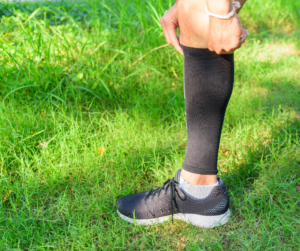
Compression
A calf compression sleeve can be used to support the calf muscles and enhance circulation in your lower leg.
Scientific literature is not 100% sold on this, and it seems to be a very subjective feeling. So if you feel it works for you then go for it
Wearing compression sleeves can help aid in the recovery of calf tightness and can provide some immediate relief.
In this article we discuss The Unknown Truth About Compressions Socks, check it out if compression socks are something you use or are considering using.
Rolling Your Muscles
Foam rollers can be used to relieve tension in the calf muscles if done properly.
You can target the different muscles and areas of your calves by positioning your legs differently on the roller and applying pressure by using your body weight.

Massage Therapy
Sports massage therapy can help to relax your muscles as well as improve your flexibility.
A massage therapist will know how to relieve the tension in your calves and enhance circulation in your calves which will help with recovery and healing.
The RICE method
Rest, Ice, Compression, and Elevation are good rules of thumb for immediate treatment for tight or sore calves and can help reduce possible damage to the muscles.
Physical Therapy
If you suffer from chronic tightness or pain in your calf muscles, consider going to see a physiotherapist who can then recommend more specialized stretches and treatments to suit your specific needs.
There is much truth in the old adage that prevention is better than cure.
Strength and foot core are key for this.
If you want to avoid missing out on running due to your calves tightening up then there are a few things you can do…
How To Prevent Your Calf Muscles From Tightening Up
Warm-up Before & Stretch After You Run
Stretching is one of the main ways to prevent tightness and pain in your calves during or after exercise. Make sure you warm up before you start running to get the blood flowing and to warm up the muscle fibers in your calf.
Stretching after you run helps alleviate any stiffness or tightness as you cool down.
Improve every run by doing this first:
Wear The Right Shoes
Make sure you have a good quality pair of running shoes that provide enough support for your feet and ankles so that you don’t put any extra strain on your calves.
It’s also important to look at the drop of your running shoe.
The drop is the difference in height between the heel of your running shoe and the toe of the shoe. The drop affects the angle of your foot in relation to your calf muscle.
Changing from a higher-drop running shoe to a lower-drop running shoe will put added strain on your Achilles tendon and calf muscle due to the change in angle.
It is therefore important to ensure you are running in the right pair of shoes for you.
Regular Massage Therapy
If your budget allows for it, try to go for massage therapy regularly.
Massage therapy can help relieve tension and enhance blood circulation so that your muscles stay strong and in good shape.
Regular sports massages also help pick up any problem areas before they become major injury concerns.
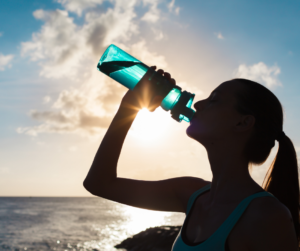
Eat Well & Stay Hydrated
Eating a balanced diet and drinking enough water throughout the day helps to ensure that your muscles and your body are healthy and can cope better with physical activity.
Note: It’s not an electrolyte imbalance that causes cramping.
Pro Tip: Failing to prepare an adequate hydration strategy before race day can lead to unwanted consequences…This is how to hydrate correctly.
Strength and Conditioning Training
Improving your overall fitness and adding some strength work into your training schedule can also help to prevent tightness in your calves.
Strength work will help you to condition your muscles to ensure you’re not putting any extra strain on your calves or any other parts of your body.
The free strength training plan below is a perfect addition to any running training plan.
Making sure you do the correct strength training is important. The good news is we’ve created a free strength training plan for runners that you can download by clicking here.
As mentioned already stretching the calf muscles can go a long way to preventing and treating tightness and stiffness in your calves.
Stretches For Tight Calf Muscles
Note: It’s important to do these after you have warmed up correctly and not to overextend the muscle.
The Wall Stretch
Stand with your hands up against a wall and step back with one foot keeping your leg straight and your heel on the ground or as close to the ground as you can get.
This will stretch out the Gastrocnemius muscles.
If you stay in the same position and bend your knee, you will feel the stretch deeper in your calf in your Soleus muscle. Hold the stretch for about 30-60 seconds at a time.
To add a soleus stretch, do the same as above but with your back leg bent
Eccentric Calf Raises
Stand on a step with the balls of your feet so that your heels hang off the edge. Rise onto the balls of your foot and then slowly lower your heels below the step.
Go back up onto the balls of your feet and repeat. You can hold onto a rail or wall to help you keep your balance during this stretch.
Note: This is a strength exercise not a stretch and is an important strength exercise for calves.
You could also add in the calf raise with a ball, as well as heel walks as this strengthens the front of the shin.
Double Calf Stretch
Stand facing a wall with your legs hip-width apart. Put your hands on the wall and lean forward while keeping your heels on the ground.
Bending your knees slightly can help stretch the muscles more if you’re not feeling it.
Single-Leg Calf Stretch
Sit on the floor with one leg stretched out in front of you and the other bent inwards. Then lean forward, lowering your chest towards your leg, and reach for your toes with your hands or a band while flexing your foot.
Downward Facing Dog
This move is great for stretching your muscles after a workout.
Start on all fours with your knees below your hips and your hands below your shoulders. Step back onto your feet to go into a high plank and then raise your hips so that your body forms a triangle with the ground.
Keep your back straight and place most of your weight onto your legs.
Then bend one knee and push the heel of your other foot into the mat to stretch the calf.
Hold this position for about 10-15 seconds and then swap legs and repeat.
Tight calves are not a cause for concern unless…

When Should You See a Doctor?
Even though calf tightness and pain usually disappear with stretching, compression, foam rolling, sports massages, the RICE method, and physical therapy.
You should consult a doctor if you are experiencing sudden & severe pain in your calves, recurrent symptoms, or when a reduction in training load has not reduced the calf pain.
Sometimes the right treatment has to be given quickly to avoid long-term health problems.
The calf muscles play a huge role in running, and avoiding tight calves by using the methods outlined above will go a long way to keeping you injury-free and on the road or trails where you belong.



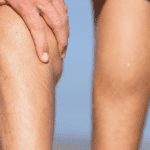
Comments are closed.